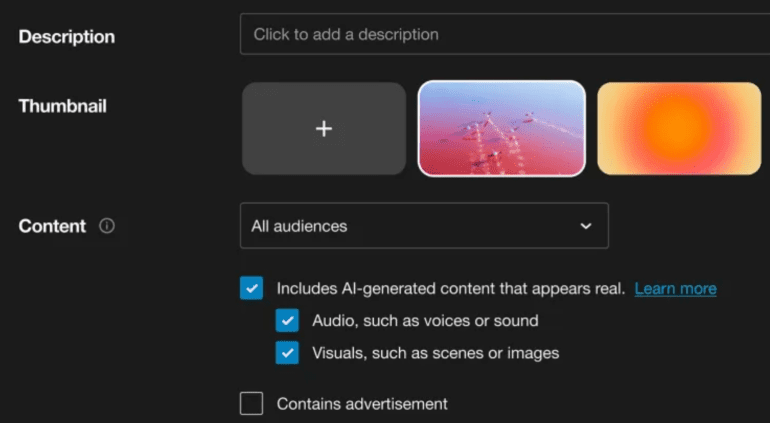- Vimeo introduces AI content labels for videos created using AI tools.
- The labels aim to distinguish between AI-generated and real content to prevent viewer confusion.
- Creators must disclose when AI is used to create realistic content, such as altering real events or people.
- Vimeo allows creators to specify AI use for audio, visuals, or both during video uploads.
- Future plans include developing automated AI detection systems to streamline content labeling.
Main AI News:
Vimeo has joined the ranks of TikTok, YouTube, and Meta by implementing new measures for creators to label AI-generated content. The video hosting platform announced on Wednesday that creators must now inform viewers when realistic content has been created using AI. This update to Vimeo’s terms of service and community guidelines aims to prevent confusion between real and synthetic content generated through advanced AI tools.
While Vimeo does not require disclosure for clearly unrealistic content, such as animated videos or those with obvious visual effects, it mandates AI content labels for videos depicting altered footage of real events or individuals, or showcasing AI-generated creations mimicking real people or places.
Moreover, Vimeo has introduced distinct AI content labels that will appear prominently on videos utilizing its suite of AI tools, including features that enhance audio and visual quality by eliminating pauses and disruptions in speech.
Creators uploading or editing videos can now select a checkbox indicating the use of AI, specifying whether AI was employed for audio enhancement, visual modifications, or both. Currently, Vimeo relies on creators to voluntarily label their AI-generated content, although plans are underway to develop automated systems for detecting and labeling such content.
In an official blog post, CEO Philip Moyer outlined Vimeo’s commitment to transparency, expressing the company’s long-term goal of implementing automated AI detection systems. These systems are aimed at enhancing transparency and reducing the compliance burden on creators, ensuring viewers are informed about AI involvement in content creation.
Moyer, who assumed the CEO role in April, has previously emphasized Vimeo’s stance on AI ethics, underscoring efforts to safeguard user-generated content from misuse by AI technologies. Similar to YouTube’s policies, Vimeo prohibits the training of generative AI models using videos hosted on its platform, aligning with broader industry efforts to maintain integrity and authenticity in digital content creation.
Conclusion:
Vimeo’s introduction of AI content labels marks a significant step towards enhancing transparency in digital content creation. By requiring creators to disclose AI use and implementing visible labels, Vimeo aims to mitigate the risks of misinterpreting synthetic content as real. This move aligns with growing industry efforts to maintain authenticity and trust in online media, setting a precedent for other platforms to adopt similar transparency measures. For the market, this signifies a proactive approach towards responsible AI integration in digital platforms, potentially influencing user trust and regulatory expectations in the evolving landscape of online content creation.

